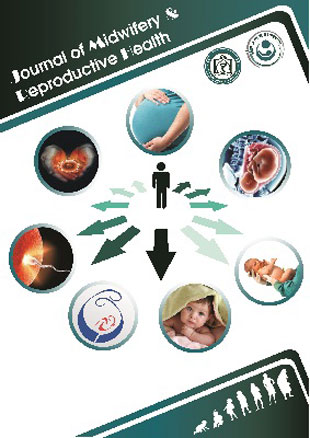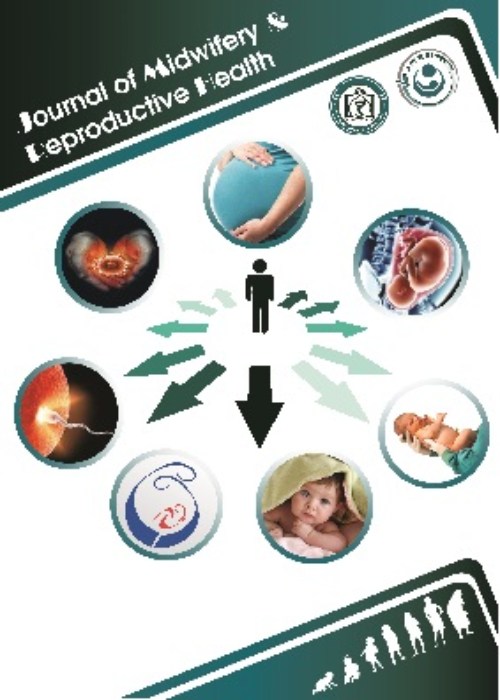فهرست مطالب

Journal of Midwifery & Reproductive health
Volume:1 Issue: 1, Jan 2013
- تاریخ انتشار: 1392/07/14
- تعداد عناوین: 8
-
-
Pages 1-3Postpartum haemorrhage remains one of the main leading causes of maternal mortality across the world. This is despite a wide-spread coverage of active third stage of labour care in many countries. Reflecting on emerging evidence in this context, a discussion of associated factors which should be considered in interpretation of the evidence and its implications is presented below.
-
Pages 4-6Although nuchal cord is a common occurrence at birth, there is little attention to its importance or management at birth, and teaching includes premature clamping and cutting of the cord as the common option. Although grade 1 evidence is lacking, the optimal management of the nuchal cord, the Somersault manoeuvre is not taught or included in any current guidelines. What evidence there is, presented in this review.
-
Pages 7-12IntroductionOne of the key aspects of maternal care is observing the progress of labor. Careful assessment of labor progress could provide mothers to be referred on time and could decrease the maternal and neonatal morbidity. This study aimed to compare diagnostic accuracy of purple line with transvers diagonal of Michaelis sacral rhomboid to predict labor progress in nulliparous and multiparous women.MethodsIn this double-blind diagnostic accuracy study, 350 nulliparous and multiparous womenwith a single pregnancy in vertex presentation and gestational age of 38-42 week, who admitted in Om-ol-Banin Hospital, Mashhad, Iran, from April to August 2012, were selected using convenience sampling. At first, the transvers diagonal of the Michaelis sacral rhomboid area was measured in cervical dilatation of ≤ 3 centimeters. Then, labor progress and presence or absence of purple lines between the buttocks in the lateral position was hourly controlled in the active phase of labor. Data were analyzed by SPSS Version 16 using Mann-Whitney and Chi-square test.ResultsThe mean age of the women was 25/22 (±5) years. Out of the 350 women enrolled, 61/2% were primigravidas and 38/8% were multigravidas. The presence of purple line was accompanied with normal labor progress with 68.57% sensitivity, 42.66% specificity, and 80.57% validity. The transverse diagonal of the Michaelis sacral cut-off point was ≥98.5 millimeter with 86.5% sensitivity, 59.45% specificity and 79.65% validity, which was also accompanied with normal progress of labor.ConclusionConsidering the diagnostic accuracy of transverse diagonal of the Michaelis sacral and purple line, thetransvers diagonal of Michaelis Sacral is more accurate predictor of labor progress.Keywords: Diagnostic test, labor, Purple line, Transverse Diagonal of the Michaelis Sacral
-
Pages 13-18IntroductionPTSD is one of the anxiety disorders which occur in postpartum period. The prevalence of PTSD – induced by preeclampsia has been already reported as 28%, however no study was found to compare PTSD in primiparous and multiparous women. This study was therefore conducted to compare PTSD in primiparous and multiparous women.MethodsThis comparative descriptive study was performed on 100 pregnant women with preeclampsia including 56 primiparous and 44 multiparous women who selected conveniently from labor wards of university hospitals in Mashhad, Iran in 2012. PTSD was diagnosed by psychiatrist interview and Perinatal Post-traumatic stress Questionnaire (PPQ) in 6th week postpartum. Social support was measured using Hopkins questionnaire in 2nd and 6th week postpartum. Data analyzed with SPSS Version 16 using Spearman correlation coefficient and Mann-Whitney test.ResultsThe rate of PTSD was 24% in primiparous and 37.8% in multiparous women. There was no significant difference in relation to mean score of PTSD in primiparous and multiparous women. Mean score of social support in 2nd and 6th week postpartum was significantly higher in primiparous women (P=0.000). 34% of multiparous vs. 5.4% of primiparous women had unwanted pregnancy (P=0.000). There was also a direct relationship between postpartum social support in 2nd (P=0.005) and 6th week postpartum (P=0.002) and the rate of PTSD.ConclusionThe rate and mean score of PTSD in multiparous has been higher than primiparous women. Thus, it seems that multiparous women are at higher risk for PTSD due to lower postpartum social support and higher rate of unwanted pregnancy.Keywords: Multiparity, Postpartum, Post, Traumatic Stress Disorder, Preeclampsia, Primiparity
-
Pages 19-25BackgroundPreeclampsia is a considerable problem of pregnancy. Endothelial dysfunction and placental hypoxia are the current hypothesis of preeclampsia. Chronic inflammation, including periodontitis may provoke systemic maternal and placental pro-inflammatory endothelial dysfunction, which represent a significant risk factor for diseases of vascular origin. So this study was carried out to evaluate the possible relationship between periodontitis and preeclampsia.MethodsA total of 360 pregnant women were included, corresponding to 180 pregnant women with mild or sever periodotitis in one group and 180 pregnant women with periodontal health in the other group. Periodontitis was determined by the sum of all pockets with pocket probing depth (PPD) ≥4mm and bleeding on probing. periodontal health was defined as the absence of PPD≥ 4mm. Then two groups evaluated to determine the presence of preeclampsia. After delivery, Child weight at birth and gestational age was also evaluated. Chi square and t test analysis were used to analyze the data.ResultsThere was statistically significant difference between two groups in presence of preeclampsia (p=0.003). Women who had a worse periodontal condition were at higher risk for preeclampsia. In addition, birth weight and gestational age was statistically lower in the case group than the control group (p < 0.001).ConclusionThe results indicate that the presence and severity of peridontitis increase the risk for occurrence of preeclampsia and adverse pregnancy outcomes.Keywords: Gestational age, Periodontitis, Preeclampsia, Pregnancy outcome
-
Pages 26-32IntroductionPostmenopausal women suffer from sleep problems due to night sweats and serotonin deficiency caused by estrogen deficiency. Considering that the cause of different reactions to menopausal symptoms including sleep disturbances has not been recognized, this study aimed to investigate the relationship between personality characteristics and sleep quality in postmenopausal women.MethodsThis correlational study was carried out on 400 postmenopausal women referred to gynecology clinics of university hospitals in Mashhad, Iranin 2012 who selected conveniently. Study tools included NEO-FFI personality characteristics questionnaire (60 items) and Pittsburgh Sleep Quality Questionnaire. Data were analyzed with SPSS software (version 16) using Pearson and Spearman correlation coefficient and linear regression analysis.ResultsThe mean age of menopausal women was 52/3 ± 4/07 years. Also mean score of menopause was 48/8 ± 3/5 years and the duration of amenorrhea was 3/8±1/5 years. The highest and lowest score of personality characteristics was related to «openness to experience» and the «neuroticism», respectively. There was a direct correlation between extroversion and sleep quality (P=0/013).ConclusionConsidering that extroverted women have a better quality of sleep, it is suggested that personality characteristics of women to be considered in the management protocols of sleep disturbances in post menopausal women. Personality Characteristics, Quality of Sleep, MenopauseKeywords: Menopause, Personality, Sleep
-
Pages 33-41IntroductionDespite growing body of literature regarding marital adjustment of infertile women, to our knowledge, there is no study to address the role of religious and spiritual beliefs in adjusting marital relationships in infertile women. Considering the significance of marital cohesiveness and commitment in the long and stressful journey of infertile women, this study was designed to explore how marital relationships are experienced by infertile women who affiliated to different religious faiths.MethodsA group of 30 infertile women affiliated to different denominations of Christianity (Protestantism, Catholicism, Orthodoxies) and Islam (Shiite and Sunni) were interviewed. The design was a grounded theory study including semi structured in-depth interviews. Data were collected in one Iranian and two UK fertility clinics through theoretical sampling and analyzed using Strauss and Corbin’s mode of grounded theory.ResultsReligious infertile women using a religious/spiritual meaning-making framework tried adjust their marital relationships through going the following phases: being optimistic and positive, having supportive relationships, being grateful and appreciated for their marital life, offering spiritual sympathy and adopting religious role models. These strategies aided infertile women to be more understanding, sympathetic and gentle towards maintaining the family cohesion.ConclusionI argue that awareness of health professionals of the potential ways in which religion and spirituality assist infertile women to deal with their marital issues could be important. This knowledge will help them to support emotional wholeness and integrity of infertile women, offering religious and spiritual coping strategies which can help adjusting their marital relationships.Keywords: Feminist grounded theory, Infertility, Perception, Religion, Spirituality
-
Pages 42-49Background and AimOne of the main strategies for keeping health is having healthy life style. Due to important role of adolescent health in community health promotion, this study aimed to determine health promotion life style in adolescent girls of high schools and its associated factors in Mashhad, Iran.MethodsThis cross- sectional study was conducted on 810 girls ranging in ages from 14to 18 years old, who were studying in high schools and selected using cluster sampling from in Mashhad, Iran in 2013. They completed questionnaires of demographic data and Adolescent Health Promotion AH scale. Data were analyzed by statistical tests of Mann-Whitney U, Kruskal-Wallis, Freedman, Wilcoxon, Spearman correlation coefficient and General linear model.ResultsThe mean age of subjects was 15.51±0.98 and the mean score of life style was 63.92±12.01. The highest score of life style subscales was allocated to the “spiritual growth or life-appreciation (77.66±15.56) and the least to the physical and sport activities (51.66±22.49). There was a significant relationship between the life style score of adolescents with parents educational level (mother P=0.024, father P=0.014). However no significant relationship was found between adolescents'' life style and their residential area and also parents'' job. Among different dimension of life style, the highest correlation was seen between spiritual growth score and life style total score (p=0.01).ConclusionBased on the findings, it is necessary to prioritize implementing of health-related educational programs in order to changing and modification of unhealthy life style related factors, with focus on sport activities as well as health and nutrition. Also it is needed to provide special facilities to select healthy living behaviors among adolescents.Keywords: Adolescent Female, Health Promotion, Life Style


